
- According to World Health Organization (WHO), “‘one health’ is an approach to designing and implementing programs, policies, legislation, and research in which multiple sectors communicate and work together to achieve better public health outcomes.”
- ‘One health’ concept recognizes that the health of the people/individual is connected to the health of the animals and environment around them.
- One Health concept is a global strategy for increasing interdisciplinary collaborations and communications in all aspects of health care for humans, animals and the environment.
- One health approach helps us to understand how diseases are shared between humans, animals and environment.
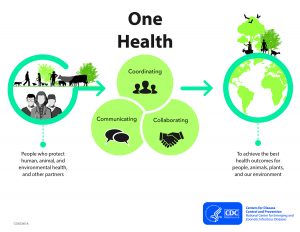
- One health focuses on the notion that – human and animal health can no more be discussed separately, rather, there is just one health.
- According to Centers for Disease Control and Prevention, “one health is a collaborative, multisectoral, and transdisciplinary approach – working at the local, regional, national, and global levels – with the goal of achieving optimal health outcomes recognizing the interconnection between people, animals, plants, and their shared environment.”
- One health approach encourages collaborative effort from experts of different fields of human, animal and environmental health (e.g. laboratorians, physicians, veterinarians etc.) to improve the health of people and animals.
Table of Contents
Key Concept of ‘One Health’ Approach:
- Many microorganisms present in our environment has pros and cons in human and animal health.
- In order to eliminate the negative impacts on the health of both animals and humans, one health approach focuses on such important areas particularly through the provision of food safety, control of zoonotic diseases, immunization, and effective coordination with various public and private sectors, which is the key concept of One Health Approach.
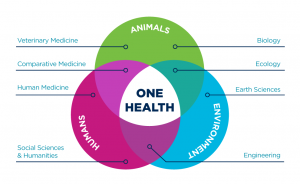
Rationale of ‘One Health’ Approach:
- In most of the cases, animals and humans are infected by the same microbes. This is because they (animals and humans) share the same eco-system.
- In this case, efforts by just one sector is not enough to prevent or solve the problem.
- Likewise, focus on just one sector of humans, animals or environment is also not adequate to solve the problem.
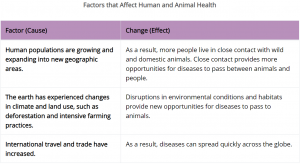
Areas of Work In Which ‘One Health’ Approach Is Mainly Relevant:
- Food safety
- Control of zoonoses (diseases that can spread between animals and humans, such as flu, rabies and Rift Valley Fever), and
- Combatting antibiotic resistance
Components of ‘One Health’ Approach:
Basically, there are four components of one health approach. They are:
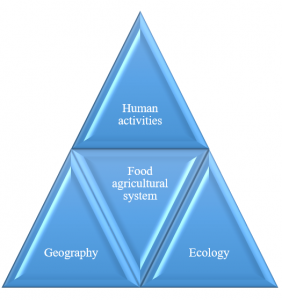
1. Human activities component:
- The fundamental importance of the integration between veterinary and human medicine into a ‘one medicine’ strategy.
2. Food agricultural system component:
- The need for a comprehensive view over the whole production chain, following a ‘farm to fork’ approach.
3. Geographical component:
- The effects of globalization of animals and animal products trade and the need for a supranational approach (the geographical component).
4. Ecological component:
- The role of wildlife and, more in general, of environmental factors in the spread and maintenance of infections.
How are Human, Animal and Environment Health Linked?
- Most of the infections that people get are spread/transmitted from animals.
- Examples: rabies, salmonella and West Nile virus infections are zoonotic diseases i.e. it can spread between animals and people.
- In some instances, animals also serve as a early warning sign of potential illness in humans. For e.g.: birds often die of West Nile virus before people get sick with West Nile virus fever.
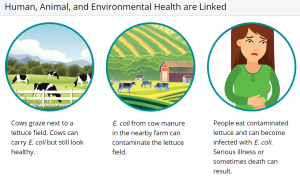
Advantages of ‘One Health’ Approach:
- Timely detection and response of disease.
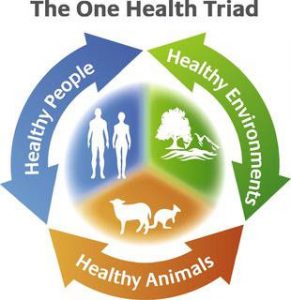
- Enhanced collaboration between various health sectors.
- Improved management, knowledge, capacity, and skill development, that helps to earn final benefits of improved health and economic efficiency.
- Enhanced public health efficacy.
- Focus on zoonotic disease prevention and elimination.
- Ecosystem services and solving disease emergence problem.
- Promotion of cost-effective analysis.
- One health approach deals with the risk of an epidemic, endemic and pandemic diseases
Limitations of ‘One Health’ Approach:
- Absence of standardized methods to measure the complexity of the benefits achieved from the holistic approach.
- Lack of systematic methodology to prove the nature of health impacts across the animal and human health sectors.
- Lack of agreement in leadership issues, resource allocation, and work distribution.
- Insufficient indicators and measures of health.
Ways To Ensure ‘One Health’ In The Current World?
- Developing effective and timely strategies to advocate emergency response on emerging and re-emerging diseases globally.
- A healthy alliance between local, governmental, non-governmental, and international authorities should be maintained to suppress chauvinistic nature to the opposite party.
- Cooperation between human, animal, and environmental health communities
- Preventing regional and international crises by controlling disease outbreaks through improved national and international emergency response capabilities.
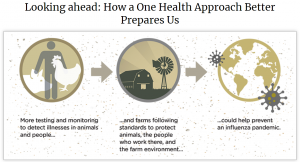
- Organizing rational disease control programs in the affected regions and the vulnerable regions through the conduct of strategic research.
- Ensure effective communication strategies between all the sectors.
- Promotion of partnerships and inter-sectoral collaboration between national and international organizations for effective functioning in emergency and other times.
- Ensure strong political commitment from all the sectors.
- Addressing health and economic issues of the marginalized community where the concerns of the poor are shifted from developed to developing economies, from potential to actual disease issues.
- Developing surveillance capacity, including the development of standards, tools and monitoring processes at national, regional and global levels.
- Developing and conducting efficient disease surveillance system.
- Planning outbreak response and preparedness activities.
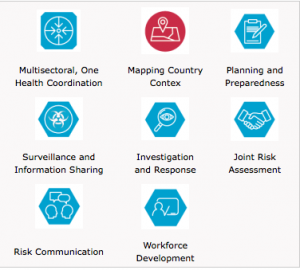
- Creating disease prevention strategies to reduce illness and death in people and animals.
- Strengthening public and animal health capacity, including communication strategies to prevent, detect and respond to disease outbreaks at national, regional and international levels.
- Capacity building for prevention, promotion, and prolonging of life.
- More focus on climate change consequences on the environment that negatively affects the health of humans, animals and their ecosystem resulting in a hazardous zoonotic disease.
- Sharing efforts in the development and evaluation of new diagnostic methods, medicines and vaccines in order to control and/or prevent diseases crossing between species.
References and For More Information:
https://www.cdc.gov/onehealth/index.html
https://www.who.int/features/qa/one-health/en/
https://www.cdc.gov/onehealth/multimedia/factsheet.html
https://bmcpublichealth.biomedcentral.com/articles/10.1186/s12889-019-6772-7
https://gh.bmj.com/content/2/1/e000121
http://www.onehealthglobal.net/what-is-one-health/
https://www.scitecheuropa.eu/one-health-approach/88605/
http://www.onehealthglobal.net/what-is-one-health/
https://onlinelibrary.wiley.com/doi/full/10.1111/tbed.12145
https://www.sciencedirect.com/science/article/pii/S2352771417300502
http://www.onehealthinitiative.com/publications/ST25%20B%20Kaplan%20-%202044%20atl%20special.pdf
https://www.oie.int/doc/ged/D14080.PDF
http://www.oie.int/downld/AVIAN%20INFLUENZA/OWOH/OWOH_14Oct08.pdf
https://thehimalayantimes.com/opinion/one-health-concept-novel-approach/
https://www.ncbi.nlm.nih.gov/pubmed/24589096
https://www.oie.int/eng/vet-education-conf2016/PTT/4.6.%20Jolly.pdf